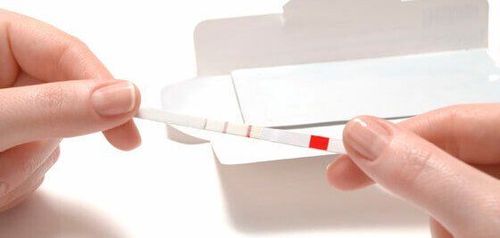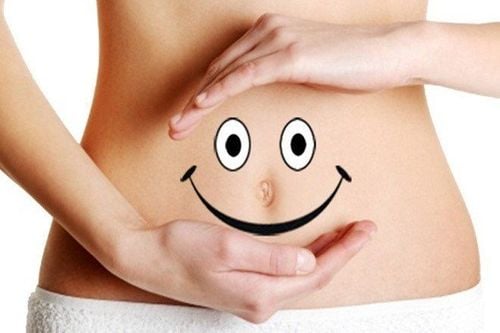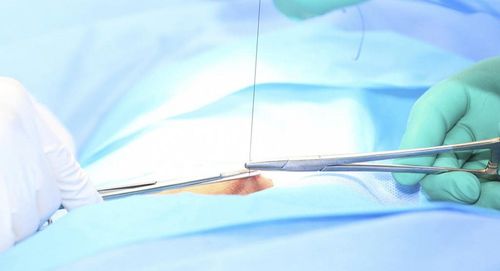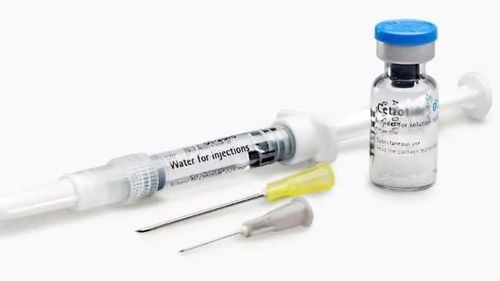This is an automatically translated article.
By learning how to recognize the signs of ovulation, you'll be able to time sex with your partner to increase your chances of getting pregnant or to make birth control more effective.Ovulation is the process by which the body releases an egg cell from the ovary. From the time 5 days before ovulation until the day of ovulation, a woman is capable of conceiving. In particular, the highest chance of pregnancy comes around the last 3 days of this ovulation process.
1. When do you ovulate?
In general, ovulation occurs in the middle of a woman's menstrual cycle. That is, if a woman has an average menstrual cycle of about 28 days, an egg can be released around day 14. However, the short length of the menstrual cycle can vary between 21 and 35 days. Some women ovulate on the same day of each menstrual cycle, but for others, this time is difficult to pinpoint.Learning how to identify and track ovulation symptoms can help a woman plan and choose when to have sex for the best pregnancy rates.
2. Symptoms of Ovulation
2.1. Common symptoms Most women have three typical symptoms of ovulation, including:Low body temperature change: Low body temperature change is the lowest body temperature at some time of the day. Immediately after ovulation, the body's lowest body temperature will increase from 0.5 to 10C and continue to increase until the next menstrual cycle. Changes in cervical mucus: Cervical mucus is a vaginal discharge that can sometimes appear in a woman's underwear. For a few days before and after ovulation, a woman may feel an increase in cervical mucus secretion as well as a change in its texture Changes to the cervix: During periods ovulating, the cervix is softer, higher, moist, and tends to widen. A woman may monitor symptoms or changes in her body over several of her cycles to try to determine when she ovulates. If they pay attention to these clues and record them on a calendar or assistive smartphone app, they can create an ovulation prediction chart. This method requires quite a lot of time and formula to be able to perform correctly.
2.2. Ten other signs of ovulation Here are ten other signs of ovulation:
Change in basal body temperature: Similar to the lowest temperature, after ovulation, a woman's basal body temperature usually tends to increase slightly. Changes to the cervix: The cervix is softer, higher, wetter, and tends to widen. Breast tenderness: Women who are ovulating may experience soreness in their breasts or nipples. Changes in cervical mucus: Increased secretion of cervical mucus during ovulation Sharper sense of smell: A woman may be more sensitive to certain scents Mood changes: A woman's emotions during ovulation can change constantly, accompanied by cravings. Water retention: Water retention can make them feel bloated Cramps : Woman may feel slight cramping in the abdomen or pain on one side of the back Light bleeding: Vaginal bleeding or discharge may occur during ovulation Increased libido : Women may feel attractive , sociable and physically attractive.

10 dấu hiệu của quá trình rụng trứng ở người phụ nữ
3. How to calculate the date of conception
There is no really effective method to predict when a woman ovulates. However, here are some ways that couples can apply to estimate the most likely time to ovulate, thereby calculating a reasonable time to have sex to increase the likelihood of pregnancy.3.1. If a woman has a regular monthly cycle with the same number of days in each cycle, she can completely apply the regular calendar method of ovulation. . To estimate the time of ovulation, a woman needs to:
Find the expected date of ovulation: To do this, count down 14 days from the expected next period Calculate the time of conception: Duration This includes the day of ovulation and the five days before that. So, for example, if day 1 is the first day of her period and day 28 is the day before her next period, then it will be easier for a woman to conceive on days 9 to 14. Focus on three days. Final. The chances of getting pregnant are highest in the last three days until ovulation rather than the days after ovulation. This is because the egg stays in the fallopian tube for 24 hours after it's released. Although sperm can stay in a woman's body for up to five days, it is common for sperm to fertilize an egg within 3 days of having sex. to estimate the period of conception of a woman, but the accuracy of this method is not too high. Even when a woman knows when to start her next period, ovulation rarely happens 14 days before the start of her next period. In a study of women with a 28-day menstrual cycle, ovulation varied from 7 to 19 days before menstruation. Ovulation that occurs on day 14 accounts for only 10% of these. All of the above shows that couples can completely miss the golden time to conceive if they use ovulation counting methods to have sex.
3.2. Using an Ovulation Predictor Kit Checking a woman's hormone levels with the Ovulation Predictor Kit (OPK) is a reliable way to determine the chances of conception even though it doesn't work good for all women. Ovulation predictor kits are of two types, including:
Urine test: This is the most common method. A urine dipstick test shows that when luteinizing hormone (LH) levels increase, it means that the ovaries are in a state of being ready to release an egg. Some tests measure levels of other hormones such as estrone-3-glucuronide (E3G) that are also increased around the time of ovulation Saliva test: In saliva testing, a microscope is used. Used to detect a dry saliva sample with an increase in estrogen or not, it should be noted that estrogen hormone levels in a woman's body will increase in the days before ovulation. Both of the above test methods give positive results in the days before ovulation, helping couples to be more active in their birth plans.

Kiểm tra nồng độ hormone trong cơ thể người phụ nữ bằng bộ công cụ dự đoán rụng trứng (OPK) là một cách đáng tin cậy để xác định cơ hội thụ thai mặc dù nó không hoạt động tốt đối với tất cả phụ nữ
4. How to check the cervix for signs of ovulation
If other signs are obvious, such as a change in basal body temperature or increased mucus in the uterus so that ovulation can be detected early, a woman will not need to check her cervix. But in case of any uncertainty, cervical screening will provide the best information for a woman to calculate her ovulation date.Many women are not used to touching the cervix so when they check, they don't know exactly how it feels? (e.g. is it softer or more expansive than usual?). Here's what to know about cervical screening:
Check mucus consistency: The best way to check the cervix is to start checking the mucus they secrete. During the period of about five days before ovulation, you will feel the sudden change in cervical mucus as it becomes thicker and stickier. Insert the middle finger into the end of the second knuckle: To check the cervix, insert the middle finger into the vagina at least as far as the middle knuckle or more. Notice how the cervix feels to the touch. Right before ovulation, the cervix will soften.

Tử cung tăng tiết chất nhầy cũng là dấu hiệu để phát hiện sớm giai đoạn rụng trứng
Please dial HOTLINE for more information or register for an appointment HERE. Download MyVinmec app to make appointments faster and to manage your bookings easily.
Reference source: babycenter.comSEE MORE
Natural contraception by calculating the day of ovulation Great tips to calculate the day of ovulation to help couples easily conceive How to calculate ovulation for women with irregular menstrual cycles













